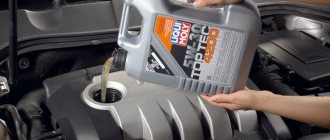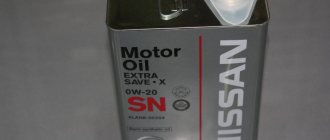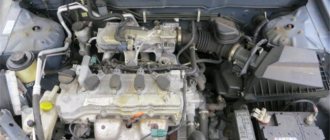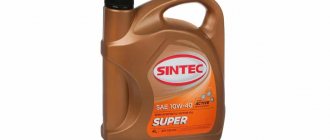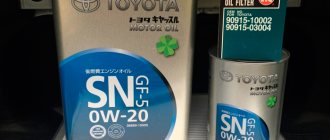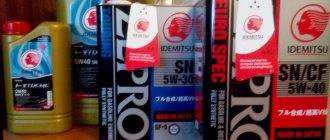Issues discussed in the material:
- How often should you change the engine oil in your car?
- How to choose motor oil
- How to choose engine oil viscosity
- How to choose engine oil according to API
- Where to buy motor oil
- How to change the oil in your car yourself
Today the market offers such a wide range of motor oils that choosing the ideal option can be quite difficult, because too many factors have to be taken into account. In our article we will talk about how to choose the engine oil that is most suitable for your car.
When to change engine oil
Many car enthusiasts think about choosing engine oil only at the moment when it is time to change it. And this moment most often does not come after 10 thousand kilometers, as most manufacturers indicate. Here a lot depends on the conditions in which the machine is operated. Some circumstances force you to change the oil earlier, every 8-9 thousand kilometers. Among these factors:
- frequent dustiness of the air;
- very coldy;
- frequent temperature changes;
- bad roads or almost complete absence of them;
- operation of a machine for transporting heavy loads.
How to choose motor oil
1. Follow the vehicle manufacturer's recommendations.
When choosing engine oil, be sure to study the car’s service book and take into account all the recommendations indicated there. If for some reason it is impossible to look at the instructions, ask for advice from an official dealer of the model or a store that sells spare parts for cars of your brand. The necessary data is most often presented in the form of a code - the car manufacturer’s oil approval for a particular type of engine. This code can be in either the international classification (SAE, API, ILSAC) or the European classification (ACEA). Each type of mixture has a specific chemical composition and a set of additives. Choosing the wrong engine oil can increase fuel consumption, reduce engine performance, and even cause engine damage.
2. When choosing, consider the brand of the previous engine oil.
Many car enthusiasts buy used cars. In this case, you should definitely ask the previous owner what oil he used last time. The fact is that two different types of oil can enter into an undesirable chemical reaction with each other, which will negatively affect the functionality of the engine.
If it is impossible to obtain the necessary information, be sure to flush the car engine before changing the oil.
3. Choose only certified motor oil.
Knowing what oil was last used and taking into account the manufacturers' recommendations, begin to look for the most suitable mixture for your car.
Moreover, when choosing motor oil, be guided not by the advice of companies that produce these products, but by the recommendations of the car manufacturer. Try to be critical of the statements of managers of specialized stores who convince you to buy the “newest and best” oil. The seller may not be lying, but this does not mean that the recommended product is best suited for your car.
4. Don't forget to pay attention to the type, grade and viscosity of the oil.
The more you narrow down your choices, the easier it will be for you to settle on a specific brand. Remember that in their recommendations, car manufacturers often indicate the possibility of using several brands of oil from the same company.
However, certain brands often have significant differences from each other. Oils can be mineral, synthetic and semi-synthetic, have different classes and different viscosities. When choosing the last parameter, consider the following point: the high-temperature viscosity of the oil should be higher if the car engine has been in operation longer and the car has a high mileage. Of course, the viscosity parameter of the engine oil should be selected within the limits allowed by the car manufacturer.
When choosing other properties of the product, take into account the characteristics of the previously used oil, and also follow the manufacturer’s instructions.
What does "with the approval of the automakers" mean?
Automobile companies can put forward a variety of requirements for oil. Only those oils that have been approved in their own or independent laboratories after careful testing of the product properties can be filled into the engines of cars from American and European manufacturers. As for Japanese, Chinese and Korean companies, they do not have their own approvals for motor oils. However, they require the use of only oils that meet the standards of the international API or ILSAC classifications.
Automobile manufacturers issue approval to products only after a series of bench and motor tests in independent laboratories that can confirm the level of performance properties of the oil. Only by using an officially approved product can you be sure that it will not harm your car's engine. But if trouble does happen and the car’s engine fails precisely because of the oil approved by the manufacturer, the car company is obliged to compensate the vehicle owner for repair costs.
Classification
The use of oils of a class lower than those recommended by the manufacturer leads to malfunctions and significant engine wear. But high-quality lubricants are often incompatible with a particular engine. Therefore, you need to follow the recommendations of the motor manufacturer.
SAE classification
This international standard defines the viscosity index, which is an important characteristic of a lubricant. Its fluidity at low temperatures depends on its viscosity, which makes it easy to start in winter. This parameter also shows the fluidity of the oil at elevated temperatures during engine operation.
Oils are divided into winter, summer and all-season. The first of these is indicated by the letter “W” and a number in front of it. On canisters, winter oil is designated 5W, 10W. Summer oil is indicated simply by a number, for example, 20.
Currently, winter and summer oils are not available for sale, as they have been replaced on the market by all-season oils. This is due to the lack of need to change the oil seasonally. The marking of all-season oil is combined from the marking of winter and summer lubricant: 5W-40.
Winter viscosity shows at what frost the oil will be sufficiently fluid. 0W oil will have good fluidity at -35 degrees. The summer index shows what the viscosity will be after the oil is heated to operating temperature.
If the car operates in the summer, under heavy loads, then viscous oils are better suited. Knowledgeable drivers take these features into account and choose suitable all-season lubricants. Brands 5W40 and 5W30 have become popular. You can also drain and refill the oil from summer to winter before each season.
API and ACEA Standards
API is an American classification, and ACEA is European oil producers. They check and test the performance properties of the oil and issue it with a document.
The American certification system is the most loyal. European testing is more stringent. The main task is to analyze the parameters and determine the class. Tests are carried out in engines, on stands. Experts evaluate the anti-wear and flushing properties of oils, their ability to protect the engine from rust, antioxidant parameters, etc.
API classification
This division of motor oils gives two categories S and C. The first category is petroleum products for gasoline power units, C is for diesel engines. On the packages next to these symbols there is another letter in the form of a Latin letter. It is necessary for additional quality marking. The closer this letter is to the beginning of the alphabet, the worse the oil.
SA and SB oils are for gasoline engines, but SA is of worse quality than SB. For diesel engines, marking is done in a similar way. Currently, classes A and B are no longer used, as these are low-quality oils.
The marking next to the letters may have numbers indicating the date; these designations indicate the year of manufacture of the motors for which this brand of lubricant is recommended. Universal types can be poured into both types of engines. In the API classification there is also the EC1 marking, which means energy-saving oil. The higher the number, the greater the fuel economy.
ACEA classification
This division arose back in 1996. The main difference from the previous classification is the narrow definition of lubricant use. More emphasis is placed on anti-wear properties. The marking consists of the letter A - for gasoline engines related to passenger vehicles, the letter B - for diesel passenger cars, E - for diesel trucks.
Additionally, there is a digital marking; the higher the number, the higher the quality. Auxiliary numbers in the designation are indicated with a hyphen. They indicate the year of the specification. In 2004, another species appeared, designated "C". This is a universal oil for all engines.
When choosing, you need to look at the oil base, viscosity grade, and whether the oil complies with the engine manufacturer’s recommendations.
How to choose engine oil according to API
All oils, despite the constant introduction of additions to the classification according to conditions of use and operational parameters, are divided into two categories - “S” and “C”. If you need to choose motor oil for a gasoline engine, you should turn to the first of them - Service. The Commercial category includes oils for engines running on diesel fuel. That is, in principle, the question of how to choose the right engine oil for a diesel engine is not faced by car enthusiasts.
Category "S" has several classes. In increasing order of oil quality requirements, they are arranged as follows: SA, SB, SC, SD, SE, SF, SG, SH, SJ, SL, SM and SN. According to API classification, an oil is of higher quality if the second letter in its name is further from the alphabet. Today, the most relevant class for gasoline engines is SN, and for diesel engines – CF. However, universal oils with double markings (for example, SN/CF) are also available for sale, suitable for various types of engines.
Oils of a class higher than SL are energy-saving, that is, they save fuel. Although in fact it is difficult to feel the difference between the products of different manufacturers, because it is no more than 2-3 percent.
When choosing motor oil, make sure that the packaging is marked with at least class SM or SN. Thanks to the use of such a product, engine performance improves and oil consumption due to waste is reduced.
Oil manufacturer brand
The quality of oils from the French company Motul is highly appreciated: it took first place in the Drivers' Choice rating several times in a row. In addition to viewing reviews about a particular motor oil manufacturer, it is also worth keeping an eye on the selected parameters of these oils, which are often included in technical sheets. These include:
Viscosity index VI
This is a quantity that informs about the change in viscosity with temperature. The higher the VI index, the more stable the oil viscosity is maintained regardless of temperature. The worst oils in this regard have a viscosity index of about 100, regular ones - 140, good ones - even 180.
TBN (total base number)
This parameter provides information about the content of alkaline additives, that is, additives that neutralize acidic combustion products, such as sulfur from fuel. This number decreases with use, and choosing an oil with a higher TBN will provide longer neutralization of acid contamination.
Type of oil base
The base usually accounts for about 85% of the volume of motor oil, with another 15% being the additives used in it.
You might like Top 10 Best Cheap Electric Scooters in 2021. Rating and reviews
Motor oils can be divided into five groups:
- The first and second are mineral oils
- third - made using synthetic technology
- fourth - synthetic oils, so-called PAO (polyalphaolefins)
- the fifth is synthetic based on other technologies, for example, esters.
- oils of the last two groups are classified as true “synthetic” oils and have much better parameters than oils from groups I, II and III.
How to choose the right engine oil by viscosity
Oil viscosity is its ability to maintain fluidity while remaining on the surface of internal engine parts. Viscosity is usually assessed at 0 and 212 degrees Fahrenheit. Oils are marked using two indices. The first (winter, up to the letter W) designates the “lower threshold” of operating temperatures at which the lubricating properties are most effective. The second index (summer) is indicated by a number. The higher its value, the higher the temperature the liquid is designed for.
Using this marking you can find out the oil thickening parameters. Considering that its fluidity increases with heating, it is clear that the 10W-30 product thickens less in cold and heat than 20W-50. Properly selected oil additives can minimize the thinning of the working layer. The second number in the marking is higher if the oil is more resistant to thinning. For example, the 10W-40 product is more stable in this regard than the 10W-30 version. Protection of moving engine parts is created thanks to a denser and thicker film on their surfaces.
Many car enthusiasts are wondering: which engine oil is best to choose for the winter? Of course, one that will not begin to thicken even at a fairly low temperature. Otherwise, the engine will have to expend more energy to rotate the crankshaft partially immersed in lubricant, and the movement of engine parts will be greatly hampered. In addition, due to the high viscosity of the oil, fuel consumption will increase and problems with starting the engine may occur.
During the winter months, it is best to use motor oil labeled 5W. Although some synthetic oils are blended in such a way that they easily pass the 0W rating test, having good fluidity when cooled.
When the engine is running, the lubricant heats up, and the higher the outside temperature, the hotter it is. Which engine oil is better to choose for the summer? Look at the markings. The number 40 in the marking after the letter “W” shows that in extreme heat the lubricant will remain thicker than with the number 30. And, of course, preference should be given to the brand of oil recommended by the car manufacturer.
Motor oils: characteristics, types, types
International standards, compliance with which is stated in the characteristics of this brand of oil. In modern brands of oil, the following options may be found: - API - a standard developed in the USA by the American Petroleum Institute. Provides two separate classifications - for gasoline (API SG, , , , , SN Plus) and for diesel engines (API CI-4, CH-4, CG-4, , , ); in the first case, the first letter in the standard designation is S (for example, API SL), in the second it is C (for example, API CI-4). If the oil is suitable for both types of engines, a double designation is used - for example, API SL/CI-4; in this case, the index of the type for which the oil is best suited is put first (in our example, this is gasoline). The standard also includes the classification of two-stroke engines - TA, , , TC+, .
— ACEA is a standard used by the association of European automakers of the same name, an alternative to the American API. Includes three classes: A/B - all oils developed before 2004 for different types of engines. Actually, until 2004 there were two classes here - A for gasoline engines and B for diesel engines; then they were combined (A1/B1, A3/B3, A3/B4 and A5/B5). However, separate designations can still be used. C - oils for all types of engines, meeting the Euro-4 environmental standard and compatible with additional equipment such as catalysts and particulate filters. There are APEA C1, , , and . E - a separate class for diesel engines of heavy equipment, including special ones. Marked APEA E4, , and .
— JASO — developed by the Japanese Auto Standards Association. It is one of the main modern standards for oils for gasoline motorcycle engines, within this purpose it has two classes - F for two-stroke engines, namely FA, , , and M for four-stroke (subclass MA for wet clutch MA-1 and MA-2, for dry).
— ILSAC is a standard created jointly by the American and Japanese Automobile Manufacturers Associations. Used for oils designed for passenger cars with gasoline engines. There are only five ILSAC categories (GF-2, GF-3, GF-4, GF-5, GF-6A), in general they are similar to certain API categories (see above), but they differ in increased requirements for energy saving and limitation of harmful emissions .
A list of specific oil standards recommended by the manufacturer for a particular engine is usually indicated in the official vehicle specifications. Note that many standards are interchangeable; compatibility data (as well as a description of each individual category) can be found in specialized sources.
Which motor oil is better to choose - synthetic or semi-synthetic?
Typically, the oil originally poured into the engine by the automaker is taken as the standard. Leading companies have an oil quality rating that is never less than SL class, although the lubricant may differ in viscosity level. Most car manufacturers recommend using 5W-20 or 5W-30 oil when operating a car in the cold season. Product 10W-30 is recommended for use as an additional product in hot weather.
Oil based only on synthetics is intended for high-tech engines with excellent efficiency, found, for example, in the Chevrolet Corvette or Mercedes-Benz. Oils that have been tested in laboratory and field conditions (which is necessarily indicated in the labeling) are able to work perfectly even in critical conditions, regardless of the viscosity coefficient and even the ingress of moisture into them.
Such oils can be used without problems both in extreme heat and in severe frosts - in any case they will retain excellent lubricity. But such products also have their drawbacks. Firstly, it is quite expensive. Secondly, it is not suitable for all engines. Synthetics are simply not able to provide high-quality operation of some engines. And here you must follow the recommendations of the car manufacturers.
A semi-synthetic lubricant consists of synthetics mixed with mineral oil. The choice of such a product is often dictated by the need to protect against heavy loads and extreme heat. Semi-synthetic motor oils do not contain many volatile substances, so such mixtures evaporate more slowly, thereby saving fuel. Such oils are often purchased by owners of heavy SUVs. And for commercial vehicles, due to their increased operational load, this product is almost irreplaceable.
In addition, semi-synthetic oils are not as expensive as products made entirely from synthetics. And even when it's not about price, the balance of indicators still matters a lot.
Choosing between synthetic and mineral motor oil
Traditionally, the reference sample is the oil that the manufacturer poured into a new car. All leading brands have one quality indicator - SL, available in several viscosities. Automakers typically recommend 5W-20 or 5W-30 oil, especially for colder temperatures, with 10W-30 oil as a supplement, especially for hot climates or seasons.
These three ratings cover almost all light vehicles on the road. It is even more important to replace it regularly, not forgetting about the filter. The standard interval is 10,000 km or 4 months. The maximum permissible interval is twice a year. If your car has an electronic oil level indicator on the instrument cluster, do not ignore its readings.
Full synthetic oil is a lubricating fluid made for high-tech, high-performance engines, whether in a Chevy Corvette or Mercedes-Benz. If these oils pass stringent laboratory and real-world testing (as indicated by their labeling), this means they have superior, more consistent performance across all critical operating conditions, from viscosity index to moisture protection.
They perform better in sub-zero temperatures and maintain peak lubricity in extreme heat and hot-traffic conditions. So why shouldn't they be used? Answer: These oils are quite expensive and cannot be used in all engine models. In fact, there may be certain properties that your car's engine needs that synthetics cannot provide. Again, follow your vehicle manufacturer's instructions.
Synthetic oil - contains a certain amount of synthetic mixed with mineral oil, and is generally designed to provide protection against heavier loads and high temperatures. This usually shows that they contain less volatile fractions and therefore evaporate much less, which reduces oil loss (and increases fuel economy). They are popular with owners of heavy SUVs and commercial vehicles who need protection under intense operating conditions. And they are much cheaper than synthetics. Of course, this difference in price may not be so noticeable for the owner, but the balance of indicators is much more important than the cost.
Oil for high mileage engines. Modern cars last much longer than their predecessors, and if you like the idea of long-lasting car use and six-figure mileage, you need to choose other brands of oil that are designed for this purpose. Almost two thirds of the world's vehicles have more than 120,000 km on the odometer. Thus, oil refineries have identified this situation as an area of customer interest and have produced specialized oils recommended for these vehicles.
When your car or small truck or SUV is a little older and has really high mileage, you may notice traces of oil stains underneath it after being parked. Around this time, you need to add oil more often than when the car first left the dealership. Crankshaft seals can harden and lose elasticity, so they leak (especially in cold temperatures) and can crack.
High mileage oils contain additional sealant additives that enter the seal pores to restore their shape and increase elasticity. In the vast majority of cases, rubber seals are designed to swell enough to stop leaks. But refineries carefully select their “renewal” ingredients.
Valvoline showed us performance data for one of its "seal" components that caused most seal materials to swell, but actually reduced the rate for a certain type of rubber that tended to swell heavily from ingredients found in some other motor oils.
You may also have noticed some loss of performance and deterioration in engine smoothness as parts wear out as your mileage increases. These oils also have a definitely higher viscosity (even if the data on the can doesn't indicate it, there is a fairly wide numerical range for each viscosity grade, and high mileage oils are at the top of each.) They may also have more viscosity index modifiers. . Result?
They better seal the gaps between the piston rings and cylinders and will not be squeezed out due to significant wear of the engine bearing. They may also have higher additive content. resist wear to neutralize the process of loss of compression.
If you have an older car, then all these features can give you much more than the highest quality synthetics.
How to choose engine oil for a car with high mileage
Previously, cars did not serve their owners as long as they do today. Every third modern car has a mileage measured in six figures - more than 120 thousand kilometers. True, this state of affairs became possible thanks to the use of suitable motor oil by motorists. Today, many companies produce many brands of products, the main goal of which is to increase the service life of personal vehicles.
After parking cars with quite a lot of mileage, you may notice oil stains on the ground or asphalt. In addition, oil in such cars has to be added more often than was previously required. Often, especially in cold weather, the crankshaft seals harden and lose elasticity, which leads to cracks and oil leakage.
Due to the fact that motor oils contain special sealing additives that enter the pores of the seals, the shape and elasticity of the parts are restored. Oil manufacturers are constantly inventing new “renewing” ingredients, and this is a great help for car enthusiasts, even though most seals “know how” to swell in volume and stop leaks.
Everyone knows that the higher the mileage, the more engine parts wear out, as a result of which the smoothness of its operation decreases and performance decreases. Motor oils produced today are more viscous than they used to be. Each viscosity grade has a fairly wide numerical range. And the highest performance is achieved by products produced for cars with high mileage. In addition, they may have a greater number of viscosity index modifiers.
Thanks to such motor oils, the gaps between the piston rings and cylinders are sealed, and the lubricant is not squeezed out in the event of severe wear of the engine bearing. The available high content of wear-resistant additives helps reduce compression loss.
From all of the above, we can conclude that in many respects, oils designed specifically for cars with high mileage are better than the best synthetics.
Recommended articles to read:
- Parking brake malfunction: causes and solutions
- Citroen crossovers: high level of comfort, daring design, advanced technology
- Oil filter in Citroen: from selection to replacement
How to choose motor oil: reviews from car owners
- German quality is as always at its best
“I trust only German quality. I only take it for my car. I usually use LIQUI MOLY Top Tec 4100 5W-40 oil. I have enough oil for 15 thousand km of driving. Although perhaps we should not forget about the quality of the engine oil, how you drive and much more. I'm happy with my choice." - Ours have long learned to make normal oil.
“I spent a long time studying reviews and articles on the Internet about Russian-made oils. A bunch of different analyzes and tests. Finally, our people began to make a worthy product. Synthetic oils from Tatneft are generally in great demand. The foreign analogue is several times more expensive" - I chose it myself and I don’t regret it
“I had a Lada about 15 years ago. They advised me to fill it with BP visco oil, but I couldn’t find it. I had to pour Castrol 0W-40 for 2 years. I sold the car later, the buyer then called me and thanked me. He said the engine was like new. However, the seller of motor oils assured me that Castrol should not be poured into the VAZ, as synthetic oil could leak from the engine...” - I gave up Shell, chose Rolf - it got better
“I drove a Hyundai and used Shell oil. After a while I noticed that a lot of oil began to leak: about 100 ml for every 1000 km. During the technical inspection they found heavy carbon deposits on the pistons. I had to change the oil. I asked around among friends and acquaintances and ended up buying ROLF 3-synthetic 5W30. After use, I went back for maintenance; no carbon deposits were found on the pistons.”We recommend
“How to check the oil in an automatic transmission: detailed instructions” Read more
- What to choose
“Only Mobil engine oil. 100% the best option compared to others." - Don’t chase brands
“I only use Mitasu. I have a Mazda and used to drive mostly Mobile. But it is MITASU MOLY-TRiMER SM/CF 5W-40 that is most suitable for my car. Even in winter at -30 below zero there are no problems. Often, other motor oils did not work well in the cold. I recommend it to everyone, I'm glad I found this oil. Very pleased with the quality and price.”
Which motor oil is better to choose - with or without additives?
Improving the properties of motor oils is also possible through the use of special additives. Sooner or later, carbon deposits will form on engine parts - due to moisture, combustion byproducts, metal wear particles, rust and oxygen. Additives increase the lubricity of the product, and at the same time minimize both the formation of soot and sediment, and the harm from their appearance.
Most often, supplements include the following ingredients:
- Viscosity index optimizers. Thanks to them, when the temperature rises, the oil layer does not thin out so much.
- Cleansing components. Serve to remove deposits, usually in the form of solids. Although their main purpose is to prevent the formation of rust and high-temperature deposits.
- Dispersants. Separates solid particles while keeping them in solution. Prevents sediment or soot from forming. Certain types of additives simultaneously function as detergents and dispersants.
- Anti-wear agents. Protect metal surfaces in cases where the lubricating film is no longer continuous. The most commonly used additive is zinc phosphorus compound (ZDDP). However, manufacturers also use other compounds, for example, phosphorus and sulfur.
- Friction modifiers. Their function is to reduce friction between engine parts, which has the most positive effect on the degree of efficiency. Molybdenum, graphite and some other substances act as additives.
- Pour point depressants. When the temperature is zero degrees Fahrenheit, the oil's viscosity is low. But this does not mean that at negative temperatures the oil will flow without problems. The oil contains wax particles that can harden and thereby prevent the free sliding of parts. Temperature depressants help prevent this process.
- Antioxidants. They prevent oxidation (and, as a result, thickening) of the oil, which occurs when the engine temperature rises. However, it is not only antioxidants that control the release processes. Other additives, for example, antiwear agents, can serve the same purpose.
- Foam inhibitors. Due to the fact that the crankshaft churns the oil in the oil pan, foaming occurs. Liquid is a more effective medium than oil foam. Such additives are used to destroy bubbles and give the lubricant the desired condition.
- Corrosion inhibitors. Their task is to protect parts from acids and moisture.
It should be remembered: choosing a motor oil with many additives does not mean improving engine performance. On the contrary, you can only make things worse. For example, sulfur compounds, which have anti-wear and antioxidant properties, are quite capable of increasing gasoline consumption and having a negative impact on the operation of the catalytic converter.
Or the anti-wear balance can easily be destroyed by too high a concentration of detergent. A high content of some chemical substance in the oil can increase fuel consumption, affecting in a certain way the action of the catalyst. Anti-wear and friction-reducing additives may contain compounds that make the catalyst less effective.
The use of sulfur compounds in motor oil or gasoline is legally limited due to pressure from environmentalists. Manufacturers, of course, are trying to somehow neutralize these restrictions, trying to reduce the cost of oil production and arguing that excluding one component from a finely balanced product can lead to very negative consequences.
Types of oils by type
Mineral
The principle of creating oil is based on distillation. Crude oil is heated to produce various compounds. It depends on the temperature. This process is called “cracking”. Heavy connections go down, light ones, on the contrary, go up. Mineral oils are naphthenic and paraffinic. Paraffin ones have better characteristics, so you should choose them. To improve quality, manufacturers often use hydrocracking. It allows you to make an oil that is similar to synthetic. Only the service life of such a product is significantly reduced. In general, all mineral types quickly lose their lubricating properties, as they contain many additives. But the price of such oil is quite low.
Synthetic
The creation of such oil involves chemical reactions. They allow you to obtain a purer product. It withstands low temperatures, washes parts better and lasts longer. You could even say that this is an alternative way to obtain oil. Only with great advantages:
- the engine works well not only at low but also at high temperatures, while the load is minimal;
- good fluidity allows for better lubrication of parts and also reduces friction - this slightly reduces fuel consumption and even slightly increases engine power;
- synthetic oil practically does not lose its properties throughout the entire period of operation;
- Well resists the formation of soot, harmful deposits and oxidation.
The high price of such oils is due to the fact that it is much more difficult to produce.
Semi-synthetic
It is a middle option between these types of oils. To obtain it, the components of synthetic and mineral oils are mixed. This product is cheaper, but with good characteristics.
How to change your own engine oil
Even a beginner can cope with changing the oil in a car. The scheme in the vast majority of cases is simple:
- Warm up the car engine.
- Wait until the engine cools down. To avoid wasting time, while waiting, select a container to drain the old oil.
- Unscrew the plug at the bottom of the pan on the crankcase. To start, you should use a key, you can finish it with your hands. Keep in mind: the oil will flow out in a stream, so be careful.
- Drain the engine oil. This will take about five minutes.
- Fill the engine with new oil, but remember that it is impossible to completely update it; about 3-4 percent of the old oil will always remain inside the engine. However, this will not affect its functionality.
After draining the old oil, see if there are any contaminants or other impurities in it. In some cases, the system may require flushing.
When changing the lubricant, be sure to use a dipstick to ensure the correct oil level in the engine. To speed up the process, fill 80 percent of the lubricant first, then add little by little to the required level. Don't forget to change the filter.
The last step is definitely necessary. The fact is that after 8,000 km, the filter becomes clogged with debris and various unwanted impurities. Without replacing the filter, the bypass valve will open and the engine will start running on unrefined raw materials. In this case, you will not receive any external signals, but the motor will wear out faster.
To soften the first start of the engine, fill the new filter with lubricant to half the volume, then lubricate the rubber on the outer casing of the device.
What happens if you don’t change the engine oil on time?
You cannot count on the normal functioning of the engine if you do not change the engine oil in it on time. It should be remembered: the resource of any such product is not unlimited, after some time its properties become worse. Oil not only ceases to reduce friction between car engine parts, but also cools the engine much worse.
If you forget to change the oil on time, this can lead to quite serious problems with the engine. And then you can’t do without expensive repairs.
In an engine that has been running for a long time on the same oil, more intense friction between parts begins, which leads to rapid wear of the mechanism parts and threatens increased fuel consumption. In the worst case, the engine begins to “knock”, and then it is no longer possible to do without a major overhaul of the engine, and this is not cheap at all.
To avoid this situation, follow some fairly simple rules. Make sure that your car does not sit idle. In a car that is not started for a long time, oil begins to flow into the crankcase, and after starting the engine runs almost without lubrication.
There are situations when it is time to change the oil, but at the moment it is not possible to do this. There's no need to get upset. If the car drives one or two thousand kilometers without changing the lubricant, it’s okay, it won’t cause any special problems for the engine. But if you have driven five to ten thousand kilometers on old oil, get ready for unpleasant consequences.
Attention should be paid not only to the mileage, but also to the expiration date of the oil. Even if your car's mileage is not very high, it is not recommended to use the same lubricant for more than a year.
We draw conclusions from the above. Firstly, you need to change the engine oil in your car regularly. Secondly, it is necessary to replace the oil filter. Thirdly, it is worth changing the oil if the car was purchased second-hand. And most importantly, do not delay this matter, otherwise you will have to send the engine for major repairs or, even worse, buy a new one. Well, the most important piece of advice: purchase motor oil only from trusted suppliers.
Where to change engine oil in St. Petersburg
Our auto centers will quickly and efficiently change the oil of Citroen and any other car. Our services have been operating on the market for more than 20 years, providing high-quality servicing and repair services for cars of all brands and any year of manufacture at affordable prices. Our service stations have the latest equipment and are equipped with special tools, and our employees are highly qualified.
More detailed information can be found on our website or contact our managers directly. We will be glad to see you in our salon!
Liked? Tell your friends:


